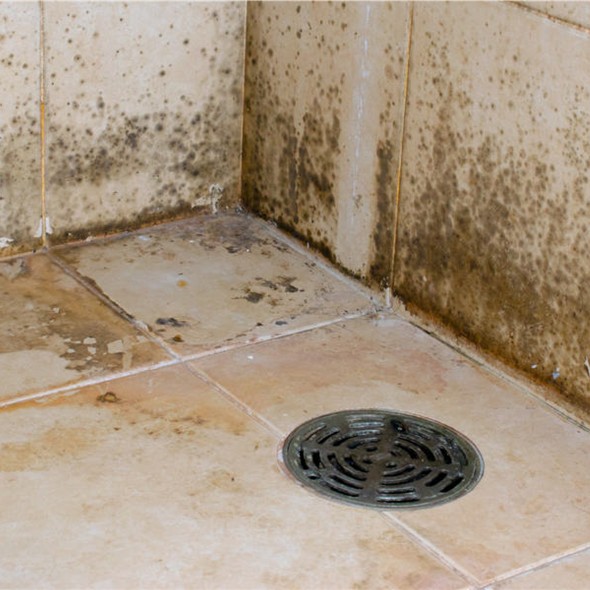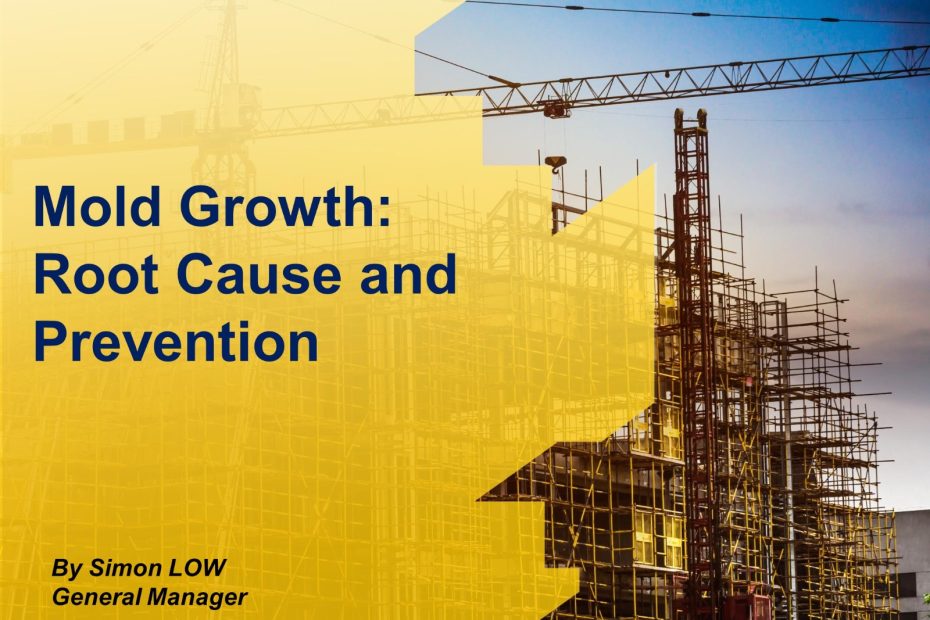Author: Simon LOW | 31 July, 2025
INTRODUCTION
Mold is a general term used to describe a variety of fungal organisms commonly found in the environment. It reproduces through tiny spores that easily disperse across various environments. The presence of mold in the natural environment may not be detrimental and is even beneficial in laboratory settings. However, it can become a problem when it appears indoors in high concentrations. It can affect the integrity of the building structure and have adverse impacts on occupants’ health, particularly for those sensitive to it.
Mold growth is influenced by two important factors which are water and nutrients [1]. In this context, nutrients refer to the food sources of mold, which include anything made of organic matter. Other factors influencing mold growth include light, temperature, exposure time, and pH. Mold prefers a slightly acidic, dark, and warm environment. Initially, at low concentrations, it is hard to detect mold, as it tends to flourish in poorly lit, hidden areas. It becomes visually detectable only when it appears as multicolored spots spreading in damp areas and emitting a musty odor.
ROOT CAUSE OF MOLD GROWTH
- High Humidity
Mold spores are highly dependent on moisture to thrive. When indoor humidity is high, excess moisture or condensation creates favorable conditions for mold growth. Daily activities such as boiling water, cooking, taking hot showers, and drying laundry indoors can significantly raise humidity levels. Additionally, higher occupant density increases humidity, as each person contributes moisture to the air through breathing, further supporting mold development[2].
Excessively damp and humid indoor air not only promotes mold growth but also leads to discomfort and potential health issues. Experts recommend maintaining indoor relative humidity between 30% and 60% [3]. To effectively reduce humidity at home, the following strategies can be adopted:- Avoid drying clothes indoors. Hanging wet towels or laundry inside can raise indoor humidity as the moisture evaporates.
- Install a dehumidifier. This device helps reduce and control indoor moisture levels.
- Dry dishes immediately after washing to minimize moisture buildup.
- Use the exhaust fan while showering to remove steam and excess moisture.
- Run the air conditioning system, which not only cools the space but also removes humidity from the air.
- Poor Ventilation
Good ventilation helps regulate temperature and humidity, while poor ventilation often leads to mold growth on indoor surfaces and can contribute to respiratory problems and structural damage. When poor air circulation combines with moisture, it creates a damp and humid environment, which is ideal for mold growth, especially in kitchens and bathrooms. Since these areas are used daily for cooking and bathing, they are high-risk zones for mold and should be kept mold-free and hygienic.To eliminate the development of mold, we must ensure good ventilation in our homes. Here are some steps we can take [4]:
- If it is safe, open windows and doors to allow fresh outdoor air in and encourage natural ventilation.
- Consider using a portable air purifier. It helps remove mold spores from the air and keeps other allergens away from our home.
- Switch on the ceiling fan to improve airflow, whether the windows are open or not.
- Leaking Pipes and Faucets
Leaking pipes and faucets create localized moisture buildup, providing ideal conditions for mold growth. Unlike mildew, mold not only forms on the surface but also penetrates it, feeding on organic matter such as tissue, mats, wood, and drywall. If not addressed promptly, the situation will worsen. Mold can begin producing spores within just 24 to 48 hours of moisture exposure, rapidly intensifying the infestation [5]. With sufficient time, mold will eventually destroy the building materials, resulting in severe structural failure.
Since mold needs moisture to thrive, the best way to prevent the growth and development of these organisms is to recognize and fix leaking pipes and faucets as soon as the problem arises. - Building Envelope Leaks
Building envelopes comprise all building components that separate the indoors from the outdoors—for example, wall assembly, foundation, roof, windows, and doors. Failure of these components will allow moisture to infiltrate the envelope, leading to mold infestation. When it rains, rainwater enters the house through the leaking roof or broken wall and stagnates. Air leakage through the air cavities of the building walls, including gaps between walls, may increase the risk of mold spore germination by bringing in moist, warm air [5].
In this case, staying on top of building envelope maintenance will help reduce damage caused by water infiltration and mold. Joints and cracks in exterior wall surfaces and around openings shall be properly sealed to prevent the entry of water, unless otherwise considered by the design. Without moisture, it is unlikely for mold to grow.
- High Humidity



CONCLUSION
Mold infestation in a home or commercial building can lead to Sick Building Syndrome (SBS) and health illnesses. When there is high humidity, poor ventilation, leaking pipes and faucets, and building envelope leaks, there is bound to be mold growth. Mold exposure and repairs after mold-related damage can be very costly to both the structure itself and the health of its occupants. It may take some care and investment to prevent mold growth, but doing so can save millions of dollars in damage in the long run. Thus, it is essential to eliminate excessive humidity and moisture at home, fix the leaking pipes and faucets in a timely manner, and perform regular maintenance on the building envelope to inhibit the development of mold.
Simon LOW
General Manager
IPM Professional Services Sdn Bhd
References:
[1] Arianna B. & Alberto S. (2021). Health and Mould Growth. Moisture and Building, 63-98. Retrieved on 31st July 2025 from https://www.sciencedirect.com/topics/engineering/mould-growth
[2] Wanda O., Mcgregor P., & Stone D. (2018). Dealing with and Preventing Mold in Your Home. Retrieved on 31st July 2025 from https://extension.umn.edu/moisture-and-mold-indoors/dealing-and-preventing-mold-your-home
[3] Marie Bannister. (n.d.). How humidity damages your home – and how to fight it. Retrieved on 31st July 2025 from https://www.airthings.com/resources/home-humidity-damage
[4] Centers for Disease Control and Prevention. (2023). Improving Ventilation in Your Home. Retrieved on 31st July 2025 from https://www.cdc.gov/coronavirus/2019-ncov/prevent-getting-sick/improving-ventilation-home.html
[5] Peter Kakoczky. (2024) How Long Does it Take for Mold to Grow? Retrieved on 31st July 2025 from https://moldsolutionsnw.com/blog/mold-growing/
[6] Yong, Dang, Xia, Yan. M., Daisuke, & Shuichi. (2020). The Effect of Air Leakage through the Air Cavities on Building Walls on Mold Growth Risks. Recent Development in Building Physics, 13(5), 1177. Retrieved on 31st July 2025 from https://www.mdpi.com/1996-1073/13/5/1177/htm
[7] Disaster Restoration Singapore. (n.d.) Mold Removal Singapore. Retrieved on 31st July 2025 from https://www.drs88.com/mold-removal-singapore/
[8] Sunrise Speciality. (n.d.) How to Get Rid of Black Mold in the Bathroom. Retrieved on 31st July 2025 from https://www.sunrisespecialty.com/black-mold-in-bathroom
[9] American Discount Plumbing. (2022, January 14). When a Plumbing Problem Causes Mold. Retrieved on 31st July 2025 from https://www.americandiscountplumbing.com/our-plumbing-blog/2018/1/14/when-a-plumbing-problem-causes-mold

